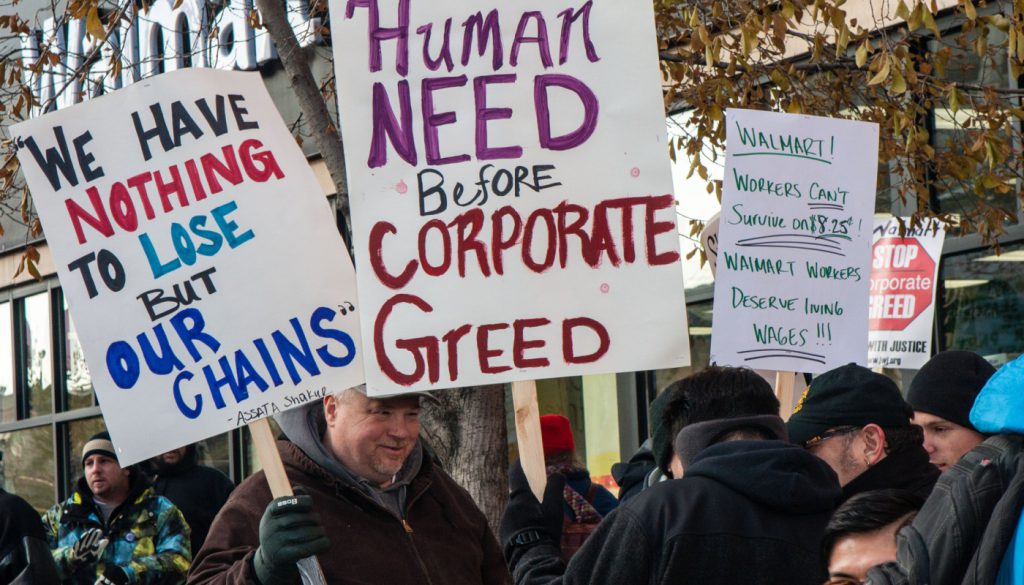The Right to Work Myth: What it Really Means for Workers

Ken Green
CEO & Founder
UnionTrack
Right to work is a deceptive concept. Packaged and sold as legislation that protects the individual freedom of workers, right-to-work laws actually diminish the power of workers and put them at the mercy of profit-hungry employers.
“Right to work may sound like a good idea, but the reality of this legislation has nothing to do with providing rights or work for the working families of America,” asserts the International Brotherhood of Teamsters (Teamsters) Joint Council 42. Yet 28 states have passed such laws under the guise of giving working people more power in the workplace.
Right-to-Work Laws are Anti-Labor Laws in Disguise
Dr. Martin Luther King Jr. knew it was wrong, writes the International Longshore & Warehouse Union (ILWU). In reality, King said, the purpose of right to work “is to destroy labor unions and the freedom of collective bargaining by which unions have improved wages and working conditions of everyone.” This was precisely the original intent of those who supported and passed the legislation.
In an effort to weaken organized labor, corporate interests successfully lobbied Congress to pass the Labor Management Relations Act of 1947 (the Taft–Hartley Act) which repealed parts of the National Labor Relations Act of 1935. Specifically, it made it illegal for employers to require union membership as a condition of employment. It also gave states the power to pass right-to-work laws that enable workers to enjoy the benefits of a union contract without having to pay union dues or agency fees to support the work of unions.
While this may seem pro-worker on the surface, it has actually done more harm than good for workers and unions. Right-to-work laws are being used as a tool for diminishing union strength by reducing union density.
Lower membership numbers equates to less money for unions that rely on dues and agency fees to fund their operations.
“Membership dues help pay for the expenses the union incurs while bargaining and enforcing contracts,” explains the United Steelworkers Union (USW). “When workers opt out, but the union still has to represent them, it limits the union’s resources therefore weakening its ability to not only bargain good contracts, but implement safety and health programs in workplaces, lobby against legislation that threatens our work and more.”
The bottom line is that workers are the ones who suffer, not prosper, under right to work. “‘Right to work’ is a clever euphemism which, like a Trojan Horse, conceals a policy designed to weaken working people and further empower corporate interests,” writes the International Union of Journeymen and Allied Trades (IUJAT).
And that is exactly what is happening in right-to-work states.

Right-to-Work Laws are Failing Working People
Working people in right-to-work states are suffering the consequences of this legislation. Studies have repeatedly shown that the lower union density usually found in right-to-work states leads to lower wages and sub-par workplace benefits such as health insurance and paid time off.
One such study, conducted in 2021 by the Illinois Economic Policy Institute and the Project for Middle Class Renewal (PMCR) at the University of Illinois at Urbana-Champaign shows “states that have collective-bargaining freedom laws have higher wages, greater health insurance coverage, better retirement security, more investment in education and worker training, fewer on-the-job fatalities, faster growing economies, less consumer debt, higher life expectancies, lower infant mortality rates, and broader civic and political engagement than ‘right-to-work’ states.”
When it comes to financial security for workers, for example, the study concludes that workers in right-to-work states earn three percent less in hourly wages than those who work in states without such laws. That number is higher for essential workers: First responders, construction workers, and registered nurses respectively earn 16, 11, and seven percent less in right-to-work states.
“This new study shows what we’ve known all along, that right-to-work doesn’t, in fact, work,” says Lonnie Stephenson, former international president of the International Brotherhood of Electrical Workers (IBEW). “It doesn’t help people and it doesn’t help states,” he says.
The study further shows people in states without right-to-work laws have better quality of life outcomes at work and at home.
“When workers have a stronger voice to bargain for better wages, benefits, training, and safety measures, it produces long-term dividends in the form of enhanced productivity, improved community health, and higher civic participation,” says Dr. Robert Bruno, PMCR director and director of the labor studies program at University of Illinois Urbana-Champaign. Such results could help explain why some states, like Michigan, are reversing course on right to work.

Michigan is First State to Repeal Right to Work
On March 24, 2023, Michigan became the first state in nearly 60 years to repeal right-to-work laws. The repeal, which will take effect in 2024, comes 10 years after right-to-work laws were passed in the historically union-dense state that subsequently saw a significant decrease in union density.
Joey Cappelletti, Michigan statehouse reporter for The Associated Press, reports that “Michigan had the nation’s seventh-highest percentage of unionized workers” before 2012. Since then, union membership has fallen by 2.6 percent dropping the state to 11th in union density in 2022. The repeal is an effort to reverse that trend and restore the power of workers and unions in the state.
“This vote signals that Michigan is prepared to lead the way once again when it comes to legally protecting workers’ rights,” says Jessica Lannon, a nurse and Michigan Nurses Association (MNA) board member.
And union leaders across the state hope the repeal is a sign of greater change that will inspire others to follow suit.
“In the short term, I know that the repeal of (right-to-work) is a small sign of the overall resurgence of the labor movement,” Nat Leach, president of the University of Michigan’s chapter of Young Democratic Socialists of America, told The Michigan Daily. “Organizers like myself in Michigan and across the nation are pleased to finally see the end of (right-to-work) and are motivated to keep fighting for the working class even more.”
The Revived PRO Act Would End Right-to-Work
Pro-labor legislators at the federal level are also working to repeal right to work by making it illegal. The Richard L. Trumka Protecting the Right to Organize (PRO) Act was reintroduced in Congress in February 2023. This legislative package is critical to workers because it closes loopholes in labor laws that have weakened workers rights.
Right-to-work is one of those major loopholes. As the AFL-CIO explains, the PRO Act would override right-to-work laws and allow unions and employers to negotiate fair share agreements that are prohibited under such laws. This ensures that unions are fairly compensated for their efforts to represent all workers in negotiating contracts that cover both union and non-union members.
Though it has failed to pass twice, now may be the right time to push the PRO Act through.
“America is in the midst of an unprecedented surge in union organizing and, because of that, our woefully outdated labor laws are being exposed for their failure to protect working people,” says April Sims, president of the Washington State Labor Council, AFL-CIO. With the backing of unions and a pro-labor president, legislators just may have the support they need to take this critical legislation across the finish line.
As unions continue to lobby at the state and federal level to end right to work, leaders can utilize a communication platform like UnionTrack® ENGAGE® to bring more awareness of the issue to members and engage them in conversations about the importance of growing union memberships.
Images used under license from Shutterstock.com.







